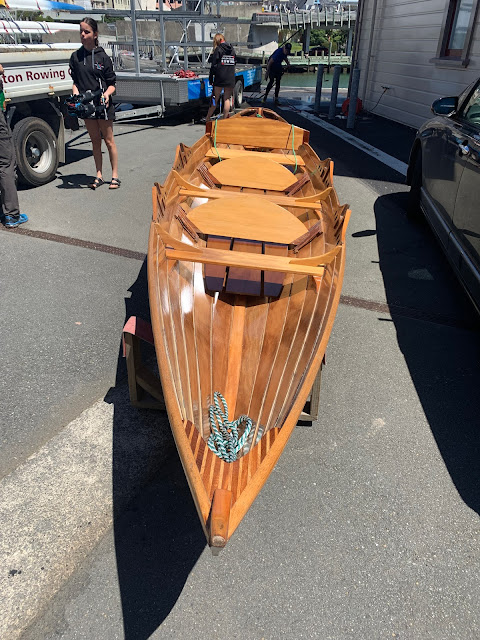With the help of some of the club women rowers, we moved the boat down to the club and put it on the water.
 |
| Joe, supervising |
A few people turned up in anticipation, including Jenny, the only other person to have done anything to build the boat (she sanded one of the oars...a bit). A few others happened to be there anyway. Everyone wanted to be involved, so we had plenty of help to get the Badger on the water.
 |
| Many hands |
The first excursion saw Kim coxing, Joe at stroke, me at Bow. I had never had any concern for its ability to float: my main worry was about how the oars would perform.
 |
| Cracking knees |
The first thing that happened was a loud crack as Joe settled his bulk on his thwart. In fairness, the stroke thwart is wider than that at bow, so it would have more scope for flexing. The problem was that the knee on one side had separated from the hull. It was a disturbing moment, but quite fixable.
Immediately, we both had difficulties with the oars: the buttons need reshaping to give a smoother turn, but the bigger issue was that, at full length at the catch or the finish, the oars would jam in the thole. The solutions will be to slim the looms and to modify the tholes, rounding them a little. (I have started on the oars: when we get back from training camp, they'll be tested again.)
This little clip records our first few strokes: clearly we are struggling to row properly (some would say that's normal for us...) and I quickly gave up trying to feather the oars.
https://youtu.be/Op0iZCFT4yE
After our initial paddle, Charlotte and a crew mate of hers had a go, then two of our club women. They had similar difficulties, though to a slightly lesser extent: rowing a little shorter, they didn't get so stuck.
At the end of the session, I went out on my own. It was delightful: the boat sat level and was very responsive. I had a sense of skating above the water and I heard the stream of bubbles that a nicely running boat should give. Whether as a single, or a double, or a coxed double, the hull performs.
 |
| Charlotte guiding me, as always |
A few teething problems to be resolved, but, overall, a successful launch. Next stop: The Mighty Waikato.














































